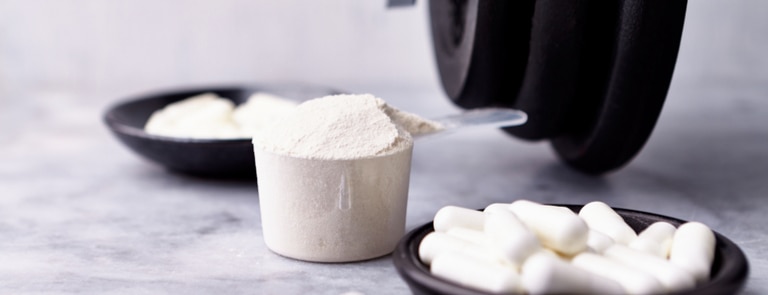10% off £30 OR 15% off £40
Code:DECIDE
Maximising your workout: is there a best time to take creatine?

Creatine is a popular sports supplement. Learn how to maximise your workouts by understanding how creatine works, how it works and the best time to take it
Summary
1How to take creatine
You may have heard about ‘creatine cycling’, which refers to the practice of cycling creatine supplementation, which involves periods of taking...
2When to take creatine for the best results
The time of day you take creatine isn’t as important as you might think. The truth is that consistency matters more than pinpointing the perfect...
3Possible creatine benefits
Creatine may be beneficial for some high-intensity sports and events that require a sprint finish, such as: cycling, rowing, triathlon...
You’ve probably heard about creatine if you’re into fitness or sports. It’s a popular supplement among athletes and fitness enthusiasts for boosting muscle gains. But when exactly should you take it? Is there a best time for optimal results?
In this article, we’ll delve into the science behind creatine supplementation and determine when may be the best time to take them in order to maximise potential benefits.
Understanding creatine
Creatine can be made by your body from protein – our body will then store it until it’s needed.1,2 The current literature has found that about 95% of the creatine can be stored in your skeletal muscles, with the rest being stored in the brain, liver, kidneys, pancreas and, if you’re a man, your testes.1-3,6
It’s believed that your body can make only about half of the creatine you need, so experts indicate that you need to top up your creatine levels through your diet. Creatine can typically be found in animal-based foods, such as meat and fish, with smaller amounts in eggs and dairy products.3,4 Vegetarian diets contain a lot less creatine, while vegan diets contain almost none.3
The good news is creatine supplements can help you boost your creatine levels and support your fitness journey. Creatine is one of the most popular dietary supplements in sports, and, although limited in research, it’s known for its potential to enhance muscle mass, performance and recovery.5
How to take creatine (and more on creatine cycling)
You may have heard about ‘creatine cycling’, which refers to the practice of cycling creatine supplementation, which involves periods of taking creatine followed by a maintenance phase.5,6,8
You don’t need to cycle creatine – the creatine cycle is a source of debate, with many deeming it ineffective while others believe it necessary, so we’d recommend seeing what works for you.
It’s generally recommended by experts to alternate between ‘loading’ creatine and a ‘maintenance’ phase, using the following steps:1,8,13
- loading phase: begin with a loading phase to supercharge your muscles. Take around 20–25g of creatine daily, split into four doses, for five to seven days. This can prime your muscles for maximum gains
- maintenance phase: once you’ve loaded up, transition into the maintenance phase. A steady daily dose of 3–5g of creatine can help keep your muscles fuelled and primed for action. It’s like putting your muscles on cruise control
While loading can help you see results faster, especially if you’re eager to jump-start your muscle gains, it’s not absolutely necessary.1 Starting with a lower maintenance dose of 3–5g per day works fine too – it just takes a bit longer to see the same benefits.1
Creatine is generally safe for long-term use, and many people choose to supplement continuously without taking a break.8 But if you feel like your gains are plateauing or you’re not seeing the same results as before, a break might be just what you need to shake things up.
When to take creatine for the best results
The time of day you take creatine isn’t as important as you might think. The truth is that consistency matters more than pinpointing the perfect moment, so find what works for you, stick with it and make it a daily habit.
Creatine is a substance that builds up in your muscles over time, so what really counts is making sure you’re getting enough of it into your system regularly. Latest research shows that whether you take it before, after or even during your workout, it’s most likely that it makes a massive difference in the long run.13–16
Possible creatine benefits
One of the potential key roles of creatine in your body can involve its storage in muscles as a substance known as ‘phosphocreatine’. Researchers in a few studies found that your muscles may use this as a reserve of immediately available energy for brief bursts of explosive-type activity, such as jumping, throwing and sprinting.6
Athletes and gym-goers have been found to favour creatine supplements to help them produce explosive energy during physical activity such as high-intensity interval training (HIIT), weightlifting and short-distance fast-paced running.6
A few, small randomised studies have shown creatine supplements may amplify the impact of resistance training on muscle strength and potentially boost physical performance during rapid bursts of intense exercise.6,7 Essentially, creatine may help you push harder during your workouts, supposedly leading to better performance and greater muscle gains but larger studies need to be conducted.6,7
Creatine may be beneficial for some high-intensity sports and short-duration events that require a sprint finish, such as:8,9
- cross-country skiing
- mountain biking
- cycling
- triathlon
- rowing
- kayaking
- track cycling
Emerging evidence suggests creatine supplements may have many potential benefits, such as:4–6,8–12
- enhancing muscle strength and power output
- increasing muscle mass
- improving exercise performance, particularly during high-intensity activities
- speeding up recovery between bouts of exercise
- supporting cognitive function, such as improved memory, and brain health
- enhancing performance and endurance in activities that rely on short bursts of maximum effort, such as sprinting, jumping and throwing
- helping regenerate the primary energy source crucial for energy-demanding processes like muscle contraction and brain function
- supporting overall athletic performance and physical response to training
Although these discoveries are promising, more research is necessary before experts can recommend creatine supplements for several of the above uses.
FAQs about creatine
Your body needs around 1–3g of stored creatine each day to maintain its normal functions suggests the latest research.8 If you’re an athlete engaging in intense training, you may need 5–10g of creatine daily to maintain body stores of creatine.8
The recommended dosage for creatine supplementation is typically around 3–5g per day.13
Creatine supplementation is thought to be generally safe to consume when taken at the recommended dose. Various studies show few creatine side effects in healthy individuals from taking creatine supplements with a dosage of up to 30g daily for up to five years.8
That said, taking too much creatine may cause stomach discomfort without any additional benefits, so we recommend taking creatine as directed on the manufacturer’s packaging and always consult a medical professional beforehand.8
Creatine supplements can come in various forms, such as powder and capsules. If you’re using creatine powder, mix it with water, juice or a protein shake, remembering to stir or shake until the powder fully dissolves.
Taking creatine with a source of carbohydrates, or carbohydrates and protein, may drive creatine into your muscles more effectively.8
There are different types of creatine available and knowing which one’s right for you can make all the difference in its effectiveness.
The final say
When it comes to timing, consistency is key. For best results, take the recommended dose of creatine daily, whether before or after your workout.
Always consult with a healthcare professional before starting a new supplement routine. While creatine is generally considered safe for most people when taken at recommended doses, it’s still essential to ensure it won’t pose any risks to your health, especially if you have pre-existing conditions.
The advice in this article is for information only and shouldn’t replace medical care. While we strive for accuracy and balance, please be aware that this article may discuss products available for purchase through Holland & Barrett. Please check with your GP or healthcare professional before trying any supplements, treatments or remedies. Food supplements mustn’t be used as a substitute for a varied and balanced diet and a healthy lifestyle.
- Antonio, J., et al. Common questions and misconceptions about creatine supplementation: What does the scientific evidence really show? Journal of the International Society of Sports Nutrition. 2021;18(1). https://doi.org/10.1186/s12970-021-00412-w
- Lopez, MJ., et al. Biochemistry, essential amino acids [Internet]. StatPearls Publishing; 2023. Available from: https://www.ncbi.nlm.nih.gov/books/NBK557845
- Ostojic, SM. Creatine as a food supplement for the general population. Journal of Functional Foods. 2021;83:104568. https://doi.org/10.1016/j.jff.2021.104568
- Kaviani, M., et al. Benefits of creatine supplementation for vegetarians compared to omnivorous athletes: A systematic review. International Journal of Environmental Research and Public Health. 2020;17(9):3041. https://doi.org/10.3390/ijerph17093041
- Wu, SH., et al. Creatine supplementation for muscle growth: A scoping review of randomized clinical trials from 2012 to 2021. Nutrients. 2022;14(6):1255. https://doi.org/10.3390/nu14061255
- Wax, B., et al. Creatine for exercise and sports performance, with recovery considerations for healthy populations. Nutrients. 2021;13(6):1915. https://doi.org/10.3390/nu13061915
- Mills, S., et al. Effects of creatine supplementation during resistance training sessions in physically active young adults. Nutrients. 2020;12(6):1880. https://doi.org/10.3390/nu12061880
- Kreider, RB., et al. International Society of Sports Nutrition position stand: safety and efficacy of creatine supplementation in exercise, sport, and medicine. Journal of the International Society of Sports Nutrition. 2017;14(1). https://doi.org/10.1186/s12970-017-0173-z
- Haugen T, Seiler S, Øyvind Sandbakk, Espen Tønnessen. The Training and Development of Elite Sprint Performance: an Integration of Scientific and Best Practice Literature. Sports medicine - open/Sports medicine - Open [Internet]. 2019 Nov 21 [cited 2024 Jul 4];5(1). Available from: https://sportsmedicine-open.springeropen.com/articles/10.1186/s40798-019-0221-0
- Avgerinos, KI., et al. Effects of creatine supplementation on cognitive function of healthy individuals: A systematic review of randomized controlled trials. Experimental Gerontology. 2018;108:166–73. https://doi.org/10.1016/j.exger.2018.04.013
- Forbes, SC., et al. Creatine supplementation and endurance performance: surges and sprints to win the race. Journal of the International Society of Sports Nutrition. 2023;20(1). https://doi.org/10.1080/15502783.2023.2204071
- Prokopidis, K., et al. Effects of creatine supplementation on memory in healthy individuals: a systematic review and meta-analysis of randomized controlled trials. Nutrition Reviews. 2022;81(4):416-427. https://doi.org/10.1093/nutrit/nuac064
- Naderi, A., et al. Timing, optimal dose and intake duration of dietary supplements with evidence-based use in sports nutrition. Journal of Exercise Nutrition & Biochemistry. 2016;20(4):1–12. Available from: https://www.ncbi.nlm.nih.gov/pmc/articles/PMC5545206/
- Ribeiro, F., et al. Timing of creatine supplementation around exercise: A real concern? Nutrients. 2021;13(8):2844. https://doi.org/10.3390/nu13082844
- Dinan, NE., et al. Effects of creatine monohydrate timing on resistance training adaptations and body composition after 8 weeks in male and female collegiate athletes. Frontiers in Sports and Active Living. 2022;4. https://doi.org/10.3389/fspor.2022.1033842
- Candow, DG., et al. Creatine O’clock: Does timing of ingestion really influence muscle mass and performance? Frontiers in Sports and Active Living. 2022;4. https://doi.org/10.3389/fspor.2022.893714
Related Articles
Shop by wellness goal
Sign up for exclusive offers
Plus, get expert advice to support your health & wellness straight to your inbox when you sign up to Holland & Barrett emails.
Read our
privacy policy














